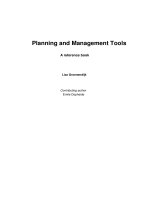PLANNING AND MANAGEMENT TOOLS: A REFERNECE BOOK docx
Bạn đang xem bản rút gọn của tài liệu. Xem và tải ngay bản đầy đủ của tài liệu tại đây (5.18 MB, 156 trang )
Planning and Management Tools
A reference book
Liza Groenendijk
Contributing author
Emile Dopheide
Cover illustration:
Paul Klee: Twins (1930). Oil painting. 60,5 x 50,5 cm. Hartford (Conn.)
U.S.A., coll. T. Kneeland.
In: Spiller, J. (1962). Paul Klee. Zwarte Beertjes, 442. A.W. Bruna & Zoon,
Utrecht. Reproduction rights: SABAM, Brussels.
Cover page design: Andries Menning
Published by:
The International Institute for Geo-Information Science and Earth
Observation (ITC)
Hengelosestraat 99,
P.O.Box 6
7500 AA Enschede,
The Netherlands
Planning and Management Tools
E. M. C. Groenendijk
(ITC Special Lecture Notes Series)
ISBN 90 6164 219 1
© 2003 by ITC, Enschede, The Netherlands
PLANNING AND MANAGEMENT TOOLS
ITC SPECIAL LECTURE NOTES SERIES
1
Table of contents
List of Figures 3
List of Tables 5
List of Boxes 7
Abbreviations 9
Preface 11
Introduction 13
Chapter 1. Problem and Objective Trees Analysis 17
Chapter 2. Logical Framework 31
Chapter 3. SWOT Analysis 43
Chapter 4. Stakeholder Analysis 55
Chapter 5. Interviews 73
Chapter 6. Workshops 95
Chapter 7. Training Needs Assessment 113
Chapter 8. Cost-Benefit Analysis 135
PLANNING AND MANAGEMENT TOOLS
2
ITC SPECIAL LECTURE NOTES SERIES
PLANNING AND MANAGEMENT TOOLS
ITC SPECIAL LECTURE NOTES SERIES
3
List of Figures
Figure 1.1. Problem Tree 19
Figure 1.2. Transforming problems into objectives 20
Figure 1.3. Objective Tree 20
Figure 1.4. Transforming a problem into a realistic objective 21
Figure 1.5. Strategy selection 21
Figure 1.6. Linking the Objective Tree to the Logical Framework 22
Figure 1.7. Discussing the final stages of the Problem Tree during ITC
Fieldwork in the Philippines
24
Figure 2.1. Schematic representation of the Logical Framework Matrix 32
Figure 2.2. Schematic representation of linked hypotheses or causal
relationship 33
Figure 2.3. The ‘If−and when−then’ relationship visualised in the
Logical Framework Matrix 34
Figure 2.4. Elements of the Logical Framework and key words
characterising these 35
Figure 2.5. Schematic representation of Interlocking Logical
Frameworks 36
Figure 2.6. Linking the Objective Tree to the Logical Framework 37
Figure 2.7. Example of a Logical Framework, Northern Province, Bogo 38
Figure 3.1. Example of a SWOT Matrix for the National Mapping
Agency in Europe
44
Figure 3.2. Example of a SWOT Matrix prepared as part of a strategy
formulation for the Student Association Board
47
Figure 3.3. Sample matrix for listing strengths, weaknesses,
opportunities and threats
48
Figure 3.4. SWOT Matrix: enhanced format 49
Figure 4.1. Women: primary stakeholders in a fuel wood project in
Kericho, Kenya 58
Figure 4.2. Schematic representation of Stakeholder Analysis 61
Figure 4.3. Stakeholder Interest Table for a proposed private sector
population project, Pakistan 63
Figure 4.4. Stakeholder Classification Matrix for a proposed private
sector population project, Pakistan
64
Figure 4.5. Conflict Matrix showing occurrence and extent of conflicts
between stakeholders in tree resources in northern
Thailand
65
Figure 4.6. Communication Matrix of stakeholders involved in activity
‘supply credit’
66
Figure 4.7. Summary Participation Matrix for the proposed private
sector population project, Pakistan 67
PLANNING AND MANAGEMENT TOOLS
4
ITC SPECIAL LECTURE NOTES SERIES
Figure 5.1. Methods of data collection 73
Figure 5.2. Both interviewer and respondent enjoying the interview.
ITC student during fieldwork in Taita Taveta, Kenya
75
Figure 5.3. Interview conducted with two interviewers in a village in
Northern Thailand
88
Figure 6.1. Performing in multi-disciplinary group work in Bagamoyo,
Tanzania
100
Figure 6.2. Seating arrangements for plenary sessions 101
Figure 6.3. Seating arrangements for working group sessions 102
Figure 6.4. A serious and productive event, in a lively environment. ITC
students during a workshop fieldwork preparation
108
Figure 7.1. Training Needs Assessment process 115
Figure 7.2. Subtraction illustrating the nature of a performance
problem
118
Figure 7.3. Taxonomy of Performance 119
Figure 7.4. Performance diagnosis matrix of enabling questions 121
Figure 7.5. Purpose-based Training Needs Assessment 125
Figure 7.6. Video recording and “think aloud” at ITC’s cartographic
research laboratory
126
Figure 8.2. NPV at various discount rates 142
PLANNING AND MANAGEMENT TOOLS
ITC SPECIAL LECTURE NOTES SERIES
5
List of Tables
Table 5.1. Overview of major interview types and their main
characteristics
82
Table 7.1. Data requirements and preferred tools and techniques 127
Table 8.1. Comparison of economic and financial CBA 140
Table 8.2. CBA decision criteria 143
PLANNING AND MANAGEMENT TOOLS
6
ITC SPECIAL LECTURE NOTES SERIES
PLANNING AND MANAGEMENT TOOLS
ITC SPECIAL LECTURE NOTES SERIES
7
List of Boxes
Box 1.1. Historical background of Problem and Objective Trees
Analysis
18
Box 1.2. Major steps in Problem and Objective Trees Analysis 19
Box 1.3. Criteria for assessing alternative options 25
Box 2.1. Historical background of the Logical Framework 32
Box 3.1. Historical background of SWOT Analysis 45
Box 3.2. Basic steps in SWOT Analysis 45
Box 4.1. Historical background of Stakeholder Analysis 57
Box 4.2. Checklist for drawing out interests 59
Box 4.3. Variables affecting stakeholders’ relative power and influence 60
Box 4.4. Checklist for assessing which stakeholders are important for
project success
60
Box 4.5. Checklist for drawing out assumptions about (and risks
deriving from) stakeholders
65
Box 4.6. Checklist for specifying conflicts 66
Box 4.7. Checklist for identifying communication linkages 66
Box 5.1. Abilities and skills required of an interviewer 75
Box 5.3. Open- and closed-ended questions: an example 77
Box 5.4. Major interview types 78
Box 5.4. Some suggestions for interview preparation 83
Box 5.5. Some useful pointers for an introduction to an interview 84
Box 5.6. Suggestions on asking questions during an interview 84
Box 5.7. Some examples of questions that may lead to
misunderstandings in interviews
85
Box 5.8. Some suggestions on probing 86
Box 5.9. Conversation illustrating probing 87
Box 5.10. Some suggestions for recording 88
Box 6.1. Examples of planning workshops 96
Box 6.2. Historical background of workshops in planning and decision-
making
97
Box 6.3. Possible objectives for organising a planning workshop 97
Box 6.4. Benefits of workshops as compared with other discussion
methods
97
Box 6.5. Some general principles of planning workshops 98
Box 6.6. Some examples of outputs for a planning workshop 98
Box 6.7. Tasks of a workshop facilitator 99
Box 6.8. The four stages of group development 100
Box 6.9. Function of games in workshops 103
PLANNING AND MANAGEMENT TOOLS
8
ITC SPECIAL LECTURE NOTES SERIES
Box 6.10. Major phases involved in developing and conducting a
planning workshop
106
Box 6.11. Some dos and don’ts for facilitators 107
Box 7.1. Historical background of Training Needs Assessment 114
Box 7.2. Examples of performance discrepancies and how they come
to the attention of the management
117
Box 7.3. Causes of poor performance 120
Box 7.4. Typical statements from managers or employees in the case
of non-training performance problems
122
Box 7.5. Causes of performance problems paired with possible
solutions
123
Box 7.6. Criteria for selecting performance solutions 123
Box 7.7. Data requirements in Training Needs Assessment 124
Box 7.8. Techniques and tools used in Training Needs Assessment 125
Box 7.9. Some questions to guide you in analysing the context for the
Training Needs Assessment
127
Box 7.10. Some questions to guide you in determining the purpose of
Training Needs Assessment
128
Box 7.11. Basic questions guiding communication of results of
Training Needs Assessment
129
Box 8.1. Historical background Cost-Benefit Analysis 136
Box 8.2. Discounting formula 141
Box 8.3. Example discounting 141
Box 8.4. Mathematical formulations of indicators of profitability 144
Box 8.5. Example of a Cost-Benefit Analysis for a hypothetical
irrigation project
145
PLANNING AND MANAGEMENT TOOLS
ITC SPECIAL LECTURE NOTES SERIES
9
Abbreviations
ADB Asian Development Bank
BCR Benefit-Cost Ratio
CBA Cost-Benefit Analysis
CEA Cost-Effectiveness Analysis
Danida Danish Agency for Development Assistance
DFID UK Department for International Development
EC European Commission
EIA Environmental Impact Assessment
FAO Food and Agriculture Organisation of the United Nations
GTZ Deutsche Gesellschaft für Technische Zusammenarbeit
IRR Internal Rate of Return
LF Logical Framework
LFA Logical Framework Approach
MCE Multi-Criteria Evaluation
MoV Means of Verification
Norad Norwegian Agency for Development Cooperation
NPV Net Present Value
NRM Natural Resource Management
OOPP Objective Oriented Project Planning
OVI Objectively Verifiable Indicator
P&C Planning & Coordination
PCM Project Cycle Management
PM Professional Master’s
SA Stakeholder Analysis
SIDA Swedish International Development Cooperation Agency
SWOT Strength Weaknesses Opportunities and Threats Analysis
TNA Training Needs Assessment
UPLA Urban Planning and Land Administration
USAID United States Agency for International Development
WB World Bank
WREM Water Resources and Environmental Management
PLANNING AND MANAGEMENT TOOLS
10
ITC SPECIAL LECTURE NOTES SERIES
PLANNING AND MANAGEMENT TOOLS
ITC SPECIAL LECTURE NOTES SERIES
11
Preface
ITC staff and students apply geosciences and remote sensing − the core
qualifications of the Institute − in the pursuit of solutions to problems. The
efficiency and effectiveness of these applications hinge on the quality of the
processes and contents of problem analysis and solution formulation. The
specific scientific and professional nature of the problems to be analysed and
the solutions to be formulated is obviously of primary concern here. In addi-
tion though, some general planning and management tools and approaches
can make a powerful contribution to structuring either the processes or the
problems at hand, or both.
Over the years technocratic approaches have generally given way to those
taking a wider angle. We now realise that the ‘old’ top-down versus bottom-
up discussion and the often mono-objective and mono-party analysis and
decision processes poorly reflect reality. Real-life allocation of resources and
implementation of commensurate action take place in an arena of conflicting
interests and multi-stakeholder cooperation and negotiation.
Over the course of time a plethora of approaches and tools has been devel-
oped to deal with the complexity and vagaries of reality. ITC teaching has
followed suit. At the moment a wide array of such approaches and tools is
being practised in the Institute. The time has come to try to standardise these
tools and approaches, for the benefit of our students and of our staff in their
capacity as teachers.
Liza Groenendijk has taken the initiative to read and process the literature on
planning and management tools, with a view to selecting and describing
those tools and approaches that come closest to meeting our students’ pro-
fessional needs. She has worked closely with staff across the Institute. This
book is the result of the work carried out over the last year in this regard.
Prof. Dr. Willem van den Toorn
Vice-chair Department of Urban and Regional Planning
and Geo-information Management
PLANNING AND MANAGEMENT TOOLS
12
ITC SPECIAL LECTURE NOTES SERIES
PLANNING AND MANAGEMENT TOOLS
ITC SPECIAL LECTURE NOTES SERIES
13
Introduction
Structure of the book
This is a tool book. Each chapter in the book presents a different tool, and
eight tools or instruments are described. Chapters 1 to 3 consider basic prob-
lem analysis and (strategic) planning instruments: Problem and Objective
Trees Analysis (Chapter 1), Logical Framework (Chapter 2) and SWOT
Analysis (Chapter 3). Chapters 4 to 6 provide tools in support of the earlier
described instruments: Stakeholder Analysis (Chapter 4), Interviews (Chap-
ter 5) and Workshops (Chapter 6). In the last chapters two specific planning
and management instruments are presented: Training Needs Assessment
(Chapter 7) and Cost-Benefit Analysis (Chapter 8).
The tools are described using the same format. Each description contains
the information necessary for a student or professional to (1) select a tool, (2)
utilise a tool, (3) understand its implications and underlying theory, and (4)
search for more information. The following paragraphs form the structure of
each chapter:
What?
Why?
Field of application
Historical overview
Description
Operating the instrument
Strengths and limitations
Requirements
Further reading
Key definitions
Definition of the tool, generally followed by the main charac-
teristics of the tool.
Importance of the described tool, indicating the tool’s main
use and strengths.
Examples of major practical applications of the tool.
Overview of how the tool has developed and become impor-
tant.
General description and explanation of main features.
Step-by-step explanation of how to use the tool.
Lists of major strengths and limitations.
Information on required resources such as time, skills and
costs.
Overview of similar tools, or tools used in combination with
the described tool.
Explanation of key words used in the text; where relevant,
synonyms are indicated.
Structure of each chapter
PLANNING AND MANAGEMENT TOOLS
14
ITC SPECIAL LECTURE NOTES SERIES
The terms used in this book reflect those generally used in the ITC training
modules. In the list of key definitions at the end of each chapter, the most
common synonyms are given.
The text is enriched with boxes and tables that summarise important text.
Flowcharts, procedures, forms and other information are presented in figures
to illustrate the text.
How to use the book
The book can be used either as a textbook or as a reference for students or
professionals involved in project planning, decision-making and management
processes. Each tool can be used for a single purpose or as part of a series
of tools combined in an overall strategy.
The book is also meant to serve as a reference book in support of education
offered at ITC. All tools presented are highly relevant to the educational pro-
grammes, and the descriptions of these tools can be used as basic lecture
material. In a number of ITC’s educational programmes some tools are more
important than others. Most of the tools are applied in the planning and im-
plementation stages of PM fieldwork, MSc research and PhD research. The
book will serve as a reference book for our students on their return home and
for their organisations.
ITC staff members form an additional target group. The basic tools described
in this book will support ITC staff members in developing research and pro-
ject proposals, in planning and decision-making at different levels, and in
consulting activities. And last but not least, it is expected that some tools will
significantly contribute to our educational performance.
Acknowledgements
The book has been prepared with the help of many colleagues. First of all I
would like to mention Emile Dopheide, who was a critical reader of all the
earlier drafts of the different chapters. His comments led to valuable im-
provements and supported me in this undertaking. He is also the author of
the last chapter, Cost-Benefit Analysis.
Literature references and comments on specific chapters were received from
Luc Boerboom, Mike McCall, Eric de Man, Mark Noort, Chris Paresi, Richard
Sliuzas, Jeroen Verplanke and Dick van der Zee. Without their support and
input this work would not have been possible.
I would like to thank Fred Paats and Ineke ten Dam of ITC’s Educational Af-
fairs Department, for their support and encouragement.
PLANNING AND MANAGEMENT TOOLS
ITC SPECIAL LECTURE NOTES SERIES
15
During the last stages of this publication, it was a great pleasure to work to-
gether with Janneke Kalf, Janice Collins, Saskia Tempelman, Benno Mas-
selink, Marion van Rinsum, Andries Menning and Ronnie Geerdink.
The driving force behind this book has been Prof. Dr. Willem van den Toorn.
He gave me the opportunity to write and complete this book in a stimulating
working environment.
Liza Groenendijk, Enschede, 31.08.03
PLANNING AND MANAGEMENT TOOLS
16
ITC SPECIAL LECTURE NOTES SERIES
PROBLEM AND OBJECTIVE TREES ANALYSIS
ITC SPECIAL LECTURE NOTES SERIES
17
Chapter 1. Problem and Objective Trees
Analysis
What?
Problem and Objective Trees Analysis is an instrument for situation analysis
and strategy analysis, and is characterised by the following steps: Problem
Tree Analysis, Objective Tree Analysis and Strategic Alternatives Analysis.
Problem and Objective Trees Analysis helps us to gain insight into the causal
relationships of forces or situations that effect the problematic situation that
an intended project is supposed to address. On the basis of a finally agreed
causal picture, general and specific objectives are formulated, which are
subsequently used to guide detailed project planning.
Problem and Objective Trees Analysis is the core element in Objective Ori-
ented Project Planning (OOPP). It represents the analytical part of OOPP
and supports the OOPP planning phase, which results in the Logical Frame-
work Matrix.
Participation is a central element in Problem and Objective Trees Analysis.
The analysis is carried out by all parties involved, and the mutual exchange
of ideas and discussions is crucial.
Why?
What management, planning and decision-making have in common is that
they are all oriented towards problem solving. A problem can be defined as
the gap between an actual state (what is) and a desired state (what should
be). Problem solving aims at bridging the gap between these two states. In
addressing problems, information is required on the existing problematic
situation and the desired situation.
Absence of a thorough problem analysis may lead to the selection of inap-
propriate or irrelevant objectives and unsustainable project results. Problem
and Objective Trees Analysis helps us to understand and structure a com-
plex problematic situation, on the basis of which a sound project proposal
can be formulated.
PLANNING AND MANAGEMENT TOOLS
18
ITC SPECIAL LECTURE NOTES SERIES
Problems are perceived differently by different groups in society. If not taken
into consideration, this may lead to insufficient participation of local imple-
menters and organisations. To create ‘ownership’ of, and commitment to, the
planning process, the direct involvement of the major parties concerned is
required in problem analysis and further project planning.
Field of application
Problem and Objective Trees Analysis has been widely used as a tool for
situation analysis in support of project design. As part of OOPP, Problem and
Objective Trees Analysis is used by different international agencies and con-
sulting firms (European Community, Danida, DFID, GTZ, Norad, SIDA,
USAID, World Bank) for the preparation of project proposals.
Although originally designed for project planning, Problem and Objective
Trees Analysis is also used for a wide variety of problem-structuring and
problem-solving activities − for example, for the preparation of research pro-
posals, as a tool in participatory planning, and in information management.
In box 1.1 a short overview is presented of the historical background of Prob-
lem and Objective Trees Analysis:
Based on the Logical Framework initially developed by USAID in 1969, a number of organi-
sations have invested considerable amounts of time and funding in developing a clear meth-
odology for proceeding through the project cycle. By the early-to-mid 1980s, GTZ had
started to use a new methodology called ZOPP (Ziel Orientierte Projekt Planung), later bet-
ter known as OOPP (Objective Oriented Project Planning). OOPP stresses the importance
of a thorough problem analysis before proceeding to the design of a project. It also recog-
nises the importance of the team process undertaken to attain it. Problem Analysis, resulting
in a Problem Tree, and Objective Analysis, resulting in an Objective Tree, are the most
prominent steps in OOPP. Problem and Objective Trees Analysis proceeds to project design
through the Logical Framework Matrix.
Many donor and non-governmental organisations have used, adopted and improved the
OOPP methodology. The core instrument in OOPP, the Problem and Objective Trees
Analysis, has increasingly become an independent tool. Although closely related to OOPP, it
is being used more and more in other methodologies and for more diverse purposes, and
can be considered a separate tool for situation analysis and strategy formulation.
Description
Problem and Objective Trees Analysis is carried out in a workshop format,
with the participation of relevant actors and decision-makers, as well as fu-
ture implementers and beneficiaries. Ideally, a facilitator guides and struc-
tures the discussions. During the workshop, visualisation and other group
communication techniques are used.
The workshop focuses on key aspects of an existing complex situation. A
point of departure could be a paper describing the current problems in the
project area.
Box 1.1. Historical background
of Problem and Objective
Trees Analysis
PROBLEM AND OBJECTIVE TREES ANALYSIS
ITC SPECIAL LECTURE NOTES SERIES
19
Problem and Objective Trees Analysis is conducted in three consecutive
steps, as shown in box 1.2.
1
Representatives of all relevant stakeholder groups participate in the Problem
and Objective Trees Analysis
2
. Usually the different steps are approached
systematically in a participatory workshop.
1. Problem Analysis
In Problem Analysis, an inventory is first made of the key problems in the
area as perceived by the different stakeholders. From this list of problems
the core or central problem is defined. With the core problem as the central
point, the other problems are grouped in a hierarchical structure reflecting
causal relationships. In this way the problem environment is graphically dis-
played in a Problem Tree (figure 1.1), with the causes forming the roots and
the effects forming the branches.
1
In OOPP it is followed by a series of
planning steps where the project is designed by develop-
ing the Logical Framework.
2
Team Technologies Inc. (2000) includes Stakeholder Analysis in Problem and Objective
Trees Analysis; it is considered the first step.
Box 1.2. Major steps in Prob-
lem and Objective Trees
Analysis
Figure 1.1. Problem Tree
(adapted from Norad, 1989)
1. Problem Analysis
2. Objective Analysis
3. Strategic Alternatives Analysis
Loss of confidence
in bus company
Economic losses
for passengers
Passengers are
hurt or killed
People arrive too
late
Frequent bus accidents
Drivers are not
careful enough
Bad condition of
vehicles
Bad condition of
roads
Vehicles are too old
Insufficient
maintenance
Drivers lack driving
skills
PLANNING AND MANAGEMENT TOOLS
20
ITC SPECIAL LECTURE NOTES SERIES
2. Objective Analysis
Subsequently, in Objective Analysis, the Problem Tree is transformed into a
set of future solutions to the problems. Each negative problem is converted
into an objective by rewording it as a positive future statement (figure 1.2).
Objectives will follow the cause-and-effect logic of the underlying Problem
Tree. Each objective will in turn be the means to the end of the objective
above it. The Problem Tree is converted into an Objective Tree (figure 1.3).
Reformulating the problems into objectives has to be done very carefully. It is
important to review the formulated objectives and the resulting Objective
Tree. If a statement makes no sense after rewording, write a replacement
objective, or delete it, or leave the problem unchanged (see figure 1.4).
Figure 1.2. Transforming
problems into objectives
(adapted from ITAD, 1999)
Figure 1.3. Objective Tree
(adapted from Norad, 1989)
Objective
Passenger confi-
dence is restored
Vehicles are kept in
good condition
Problem
Loss of confidence in
bus company
Bad condition of
vehicles
Passenger confidence
is restored
Passenger economic
losses are reduced
Few passengers
are hurt or killed
People arrive on
time
Frequency of bus accidents
considerably reduced
Drivers drive carefully
and responsibly
Vehicles are kept
in good condition
Road conditions are
improved
Old vehicles are
replaced
Vehicles are main-
tained regularly
Drivers are better
trained
PROBLEM AND OBJECTIVE TREES ANALYSIS
ITC SPECIAL LECTURE NOTES SERIES
21
3. Strategic Alternatives Analysis
The purpose of Strategic Alternatives Analysis is to identify possible alterna-
tive options, assess their feasibility, and agree on programme and/or project
strategies. Based on a set of criteria developed by the team, the particular
(group of) objectives that will apply to the intended project are strategically
chosen.
Figure 1.5 shows the means-end branches of the Objective Tree, which con-
stitute alternative options.
Option 1 Option 2
‘Better drivers’ ‘Better buses’
Figure 1.4. Transforming a
problem into a realistic objec-
tive
Figure 1.5. Strategy selection
(adapted from Norad, 1989)
Objective
Adequate rain levels
available
Problem
Irrigation systems estab-
lished and operational
Lack of adequate rain
levels
unrealistic
realistic
Passenger co
nfidence
is restored
Passenger economic
losses are reduced
Few passengers
are hurt or killed
People arrive on
time
Frequency of bus accidents
considerably reduced
Drivers drive carefully
and responsibly
Vehicles are kept
in good condition
Road conditions are
improved
Old vehicles are
replaced
Vehicles are main-
tained regularly
Drivers are better
trained
PLANNING AND MANAGEMENT TOOLS
22
ITC SPECIAL LECTURE NOTES SERIES
In this example there are two options: better drivers or better buses. Combin-
ing the two results in a third option: better drivers and better buses, which in
this case was the project strategy chosen.
Not all problems can or should be tackled by a project and not all objectives
can be embraced. Often the Objective Tree will contain objectives that can-
not be achieved by the project under consideration. However, these objec-
tives provide the external conditions of the project, which can be used to
identify the assumptions of the eventual project.
Once the project strategy has been chosen, the information from the Objec-
tive Tree is used for further project design and/or the preparation of a de-
tailed project document. When applied in the OOPP methodology, the main
project elements derived from the Objective Tree are transferred into the first
column of the Logical Framework (figure 1.6).
Operating the instrument
Step 1. Stakeholder Analysis
• Make an inventory of all persons, groups and institutions affected
by the problem environment; categorise in interest groups, indi-
viduals, organisations, authorities, etc.
• Make a more detailed analysis of these groups (e.g. in terms of
problems, interests, influence and importance, and interaction).
• Discuss whose interests and views are to be given priority.
• Select the most important groups.
• Representatives of the relevant stakeholder groups participate in
the further analysis.
Figure 1.6. Linking the Objec-
tive Tree to the Logical
Framework (adapted from
Team Technologies Inc.,
2000)
1
2
3
Interven-
Goal
Purpose
Output
Activities
PROBLEM AND OBJECTIVE TREES ANALYSIS
ITC SPECIAL LECTURE NOTES SERIES
23
Step 2. Problem Analysis
Formulate the problems
• Participants are asked to write down key problems on cards (one
problem, one card, expressed in key words).
o Existing problems − not possible, imagined or future prob-
lems.
o Only one problem per card.
o A problem is not the absence of a solution but an existing
negative state. So, no pesticides available is a wrong state-
ment; replace it with crops infested with pests.
• All cards are reviewed in plenary, and duplicates and unclear or
irrelevant cards are removed.
Select a starting point
• The core problem is identified by discussing what is the central
problem, the one problem of which most others are either
causes or effects. Very often the most striking problem, or trigger
problem, forms the starting point.
Develop the Problem Tree
• Identify substantial and direct causes of the core problem.
• Identify causes of these direct causes and place them in a lower
level.
• Identify substantial and direct effects of the core problem.
• Identify effects of these direct effects and place them in a higher
level.
Core Problem
causes
effects
Core Problem
c
auses









